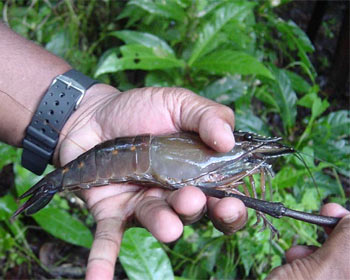
Seafood and Processing industries.

Monkey River prawn, Macrobrachium lar. (Photo: spc.int)
Prawn research achieves milestone
![]() FIJI
FIJI
Wednesday, April 04, 2012, 23:30 (GMT + 9)
The Monkey River prawn Macrobrachium lar has been successfully raised in captivity for the first time ever — from eggs through the planktonic larval phase of their lifecycle to the post-larval stage -- at the Seawater Laboratory of the Division of Marine Studies at the University of the South Pacific (USP).
Also known as ura dina, it is the largest river prawn in Fiji and the basis of valuable inland fisheries and found at local retailers and restaurants.
The Monkey River prawn has numerous favourable characteristics for aquaculture, such as its large size, widespread local recognition as a delicacy and its toughness which allows it to survive out of water for short periods.
M. lar is a native species in many Pacific Island countries with interest in developing freshwater prawn farms. Research to make breeding and rearing it more practical would let farmers avoid introducing an exotic prawn to establish freshwater prawn aquaculture in the Pacific Islands.
A major drawback to further research until now has been the inability to grow post-larvae in captivity after hatching from the egg. Past researchers could reach about Stage 6 or 7 out of 11–13, but then the larvae would mysteriously die.
Therefore, post-larvae for any culture work had to be caught by hand from the wild, which is an obstacle for larger-scale farming operations involving this species.
The success of the present study in reaching the post-larval stage is largely due to the development of a suitable feed that may better meet the nutritional requirements of the larvae, in addition to culturing it at its preferred salinity level in an appropriate environment.
Another finding of this study is that M. lar larvae develop through approximately 13 stages in the ocean before they change into post-larvae instead of 11 stages for other species. After they become post-larvae, the animals migrate landward and then settle in high-elevation freshwater streams far inland.
So far, five post-larvae have been produced at USP. They metamorphosed into post-larvae after dozens of days of culture.
For the future, however, this species still compares very poorly with M. rosenbergii, which can routinely reach post-larval stage in only 20–30 days and with 20–50 per cent survival of big batches.
This study at USP was initiated as part of an SPC-coordinated regional strategy for domesticating M. lar — through linked studies in Fiji, Vanuatu and New Caledonia — and funded by the Australian Centre for International Agricultural Research in collaboration with the SPC (Secretariat of the Pacific Community).
Separately, investigations are also ongoing on capture-based culture of M. lar for grow-out in small ponds by rural householders as a cash crop. A new technique for rearing prawn larvae — developed by Japan International Cooperation Agency Senior Volunteer Tomohiro Imamura while at USP — was instrumental in achieving this outcome.
By Natalia Real
editorial@fis.com
www.fis.com